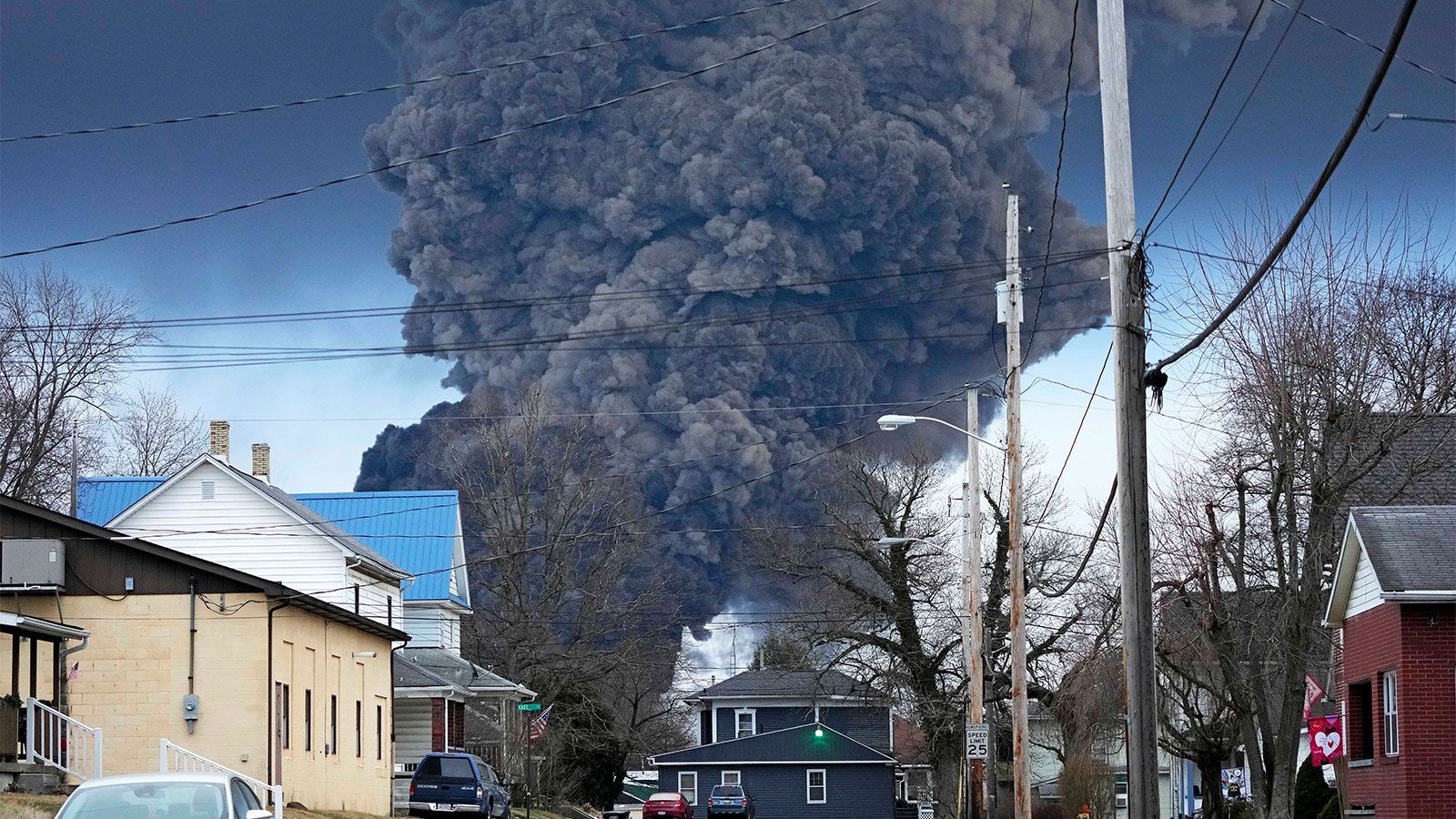Ohio Train Disaster: The Lingering Threat Of Toxic Chemicals In Buildings

Table of Contents
1. Contamination Pathways: How Toxic Chemicals Spread After the Ohio Train Disaster
The February 3rd derailment released a cocktail of hazardous chemicals, including vinyl chloride, butyl acrylate, and ethylene glycol monobutyl ether. The immediate concern was the release of these substances into the air and the potential for immediate health consequences. However, the long-term impact is far more complex and potentially devastating. The spread of these chemicals followed several pathways, posing an ongoing threat:
1.1 Airborne Contamination: The controlled burn of vinyl chloride, intended to mitigate the risk of explosion, released massive plumes of toxic fumes into the atmosphere. This airborne contamination poses a significant long-term risk.
- Types of chemicals likely to remain airborne: Vinyl chloride, a known carcinogen, and other volatile organic compounds (VOCs) can linger in the air for extended periods.
- Impact on air quality monitoring efforts: While initial air quality monitoring provided some data, continuous, comprehensive monitoring is crucial to assess the long-term impact of airborne toxins.
- Long-term health risks from inhaling these chemicals: Long-term exposure to vinyl chloride inhalation can lead to various health problems, including liver damage, and an increased risk of several types of cancer. Butyl acrylate inhalation can cause respiratory irritation and other health issues.
1.2 Surface Contamination: The released chemicals didn't simply evaporate. Vinyl chloride and other substances adhered to surfaces, contaminating soil, water sources, and building materials. This surface contamination presents a prolonged exposure risk.
- Contamination of soil, water sources, and building materials: Soil and water near the derailment site are likely contaminated, requiring extensive remediation efforts. Building materials, particularly those porous or exposed to the plume, may retain significant amounts of toxic substances.
- Methods of remediation: Thorough soil remediation, possibly involving excavation and replacement, may be necessary. Decontamination of buildings may require specialized cleaning techniques and possibly the removal and replacement of contaminated materials.
- Long-term persistence of chemicals: Some of the chemicals released may persist in the environment for years, continually leaching into the soil and water, and creating an ongoing threat.
1.3 Water Contamination: The potential for water contamination is perhaps the most far-reaching concern. Groundwater contamination could affect drinking water supplies for years to come.
- Potential for groundwater contamination: The released chemicals could have seeped into the groundwater, potentially contaminating wells and other water sources.
- Impact on drinking water: The contamination of drinking water sources would have catastrophic consequences for the health of the community.
- Testing procedures: Rigorous and ongoing water testing is vital to assess the extent of contamination and ensure the safety of drinking water. Long-term monitoring is essential to detect any delayed impacts.
- Long-term effects on human health and the environment: Contaminated water can lead to a range of health problems, from gastrointestinal issues to chronic illnesses. The environmental impact can be equally devastating, harming aquatic life and potentially contaminating the food chain.
2. Long-Term Health Risks Associated with Exposure to Toxic Chemicals
Exposure to the chemicals released in the Ohio Train Disaster poses a significant risk of long-term health problems:
2.1 Respiratory Illnesses: Inhalation of toxic fumes can lead to a variety of respiratory problems.
- Specific respiratory illnesses linked to vinyl chloride and other released chemicals: Exposure to vinyl chloride can cause asthma, bronchitis, and potentially more severe lung diseases, even lung cancer.
- Ongoing monitoring of health issues: Long-term health monitoring of residents near the derailment site is crucial to identify and address emerging health issues.
- Access to healthcare: Ensuring that affected residents have access to appropriate healthcare, including specialists experienced in dealing with toxic chemical exposure, is paramount.
2.2 Cancer Risks: Many of the chemicals released are known carcinogens, significantly increasing the cancer risk for exposed individuals.
- Specific cancers linked to the chemicals released: Vinyl chloride is strongly linked to liver cancer and other cancers. Long-term studies will be needed to fully assess the carcinogenic effects of the chemical mixture released.
- Long-term studies needed: Careful epidemiological studies are necessary to track the incidence of various cancers in the affected population over time.
- Importance of early detection: Early detection and treatment of cancer significantly improve survival rates.
2.3 Other Health Effects: Beyond respiratory issues and cancer risks, exposure can lead to other serious health problems.
- Neurological effects: Some of the chemicals released can have neurotoxic effects, causing neurological damage.
- Reproductive health impacts: Certain chemicals may affect reproductive health, leading to fertility problems or birth defects.
- Long-term health monitoring programs: Comprehensive and long-term health monitoring programs are essential to understand the full range of health consequences and provide appropriate medical care.
3. Mitigation and Remediation Strategies Following the Ohio Train Disaster
Addressing the aftermath of the Ohio Train Disaster requires a multifaceted approach:
3.1 Building Remediation: Buildings affected by the disaster may require extensive remediation.
- Decontamination procedures: Specialized cleaning and decontamination procedures are necessary to remove residual chemicals from building surfaces and materials.
- Air quality control measures: Improved ventilation and air purification systems are crucial to reduce the concentration of airborne contaminants within buildings.
- Material removal and disposal: Contaminated building materials may need to be removed and disposed of properly, following all hazardous waste disposal regulations.
- Monitoring for residual contamination: Ongoing monitoring is essential to ensure that the remediation efforts have been successful and that no harmful chemicals remain.
3.2 Governmental Response and Accountability: Effective governmental response is crucial to address the long-term consequences of this disaster.
- Federal and state involvement: Cooperation between federal and state agencies is essential for coordinating cleanup efforts, providing funding, and ensuring accountability.
- Regulatory changes: The disaster highlights the need for stronger regulations and improved safety measures regarding the transportation of hazardous materials.
- Funding for cleanup and health monitoring: Significant funding is required for the long-term cleanup, health monitoring, and support of affected communities.
- Accountability for environmental damage: Holding those responsible for the disaster accountable for the environmental damage and health consequences is crucial.
3. Conclusion:
The Ohio Train Disaster underscores the devastating and long-lasting consequences of hazardous material transportation accidents. The lingering threat of toxic chemicals in buildings and the environment necessitates a comprehensive and sustained response. Understanding the lingering threat of toxic chemicals requires ongoing monitoring of air and water quality, thorough building remediation, and comprehensive long-term health monitoring programs. We must learn from this tragedy and implement stricter regulations to prevent future Ohio train disaster scenarios. Support affected communities, advocate for stronger safety regulations, and demand accountability to mitigate the risks of chemical disasters and protect public health.

Featured Posts
-
 The Impact Of Trumps Tariffs A Ceo Perspective
Apr 26, 2025
The Impact Of Trumps Tariffs A Ceo Perspective
Apr 26, 2025 -
 The Trump Administration And The Fight Over Europes Ai Regulations
Apr 26, 2025
The Trump Administration And The Fight Over Europes Ai Regulations
Apr 26, 2025 -
 A Critical Military Installation The Epicenter Of Us China Influence
Apr 26, 2025
A Critical Military Installation The Epicenter Of Us China Influence
Apr 26, 2025 -
 Ai And Human Design An Interview With Microsofts Chief Designer
Apr 26, 2025
Ai And Human Design An Interview With Microsofts Chief Designer
Apr 26, 2025 -
 127 Years Of Brewing History Ends Anchor Brewing Company To Shut Down
Apr 26, 2025
127 Years Of Brewing History Ends Anchor Brewing Company To Shut Down
Apr 26, 2025
